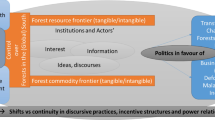Abstract
A great number of organisations and actors are participating in a plethora of international and regional fora geared towards the forest issue. Are there inherent traits about how these fora interact that can increase understanding about why the forest issue seems largely to be at a standstill? In this article I focus on the final meeting of the Intergovernmental Forum on Forests (IFF-4) and examine the overlap with the Convention on Biological Diversity (CBD) and the overlap with the Climate Change Convention (UNFCCC). How have the overlaps between these international fora been dealt with and why has one led to linkages while the other has not?
Similar content being viewed by others
References
Andresen, Steinar and Jørgen Wettestad (1995), 'International Problem-Solving Effectiveness: The Oslo Project So Far', International Environmental Affairs 7, 127-149.
Boukhari, Sophie (1999), 'Forests: A Hot Deal for a Cooler World', UNESCO Courier, December 1999, pp. 10-13.
FAO (1994), The State of Food and Agriculture, FAO: Rome.
Gillespie, Alexander (1999), Sinks, Biodiversity and Forests: The Implications of the Kyoto Protocol Upon the Other Primary UNCED Instruments, presented to the International Conference on Synergies and Coordination between Multilateral Environmental Agreements, UNU, Tokyo, 14-16 July.
Humphrey, D. (1992), The UNCED Process and International Responses to Deforestation, pre-sented to the Environmental Studies Panel Inaugural Pan-European Conference on International Studies, Heidelberg, Germany, 16-20 September.
IPCC, Intergovernmental Panel on Climate Change (1990), Report of the Response Strategies. Prepared for Working Group III, June.
Kolk, Ans (1996), Forests in International Environmental Politics. International Books: The Netherlands.
Krasner, Stephen (1982), 'Structural Causes and Regime Consequences: Regimes as Intervening Variables', International Organization 36(2), 185-205.
Kremen, C., J. O. NilesM. G. DaltonG. C. DailyP. R. EhrlichJ. P. FayD. Grewal andR. P. Guillery (2000), 'Economic Incentives for Rain Forest Conservation Across Scales', Science 288(5472), 1828-1832.
Levy, Marc, Oran R. Young andMichael Zürn (1994), The Study of International Regimes, Laxemburg, IIASA Working Paper WP-94-113.
Peters, R. L. (1988), 'The Effect of Global Change on Natural Communities', in Wilson, ed., Biodiversity. National Academy Press: Washington D.C.
Rosendal, G. Kristin (1995), 'The Forest Issue in Post-UNCED Negotiations: Conflicting Interests and Fora for Reconciliation', Biodiversity and Conservation 4, 91-107.
Rosendal, G. Kristin (1999), 'Biodiversity: Between Diverse International Arenas', in H. O. BergesenG. Parmann andØ. B. Thommessen, eds., Yearbook of International Co-operation on Environment and Development 1999/2000. London: EarthScan Press Ltd.
Rosendal, G. Kristin (2000), The Convention on Biological Diversity and Developing Countries. Dordrecht: Kluwer Academic Publishers.
Rosendal, G. Kristin (2001), 'Overlapping International Institutions: The Case of Biodiversity', Global Governance 7, 95-117.
Sheldon, Jennie Wood and Michael J. Balick (1995), 'Ethnobotany and the Search for Balance Between Use and Conservation', in Timothy M. Swanson, ed., Intellectual Property Rights and Biodiversity Conservation. Cambridge: Cambridge University Press.
Stokke, Olav S. (2000), 'Managing Straddling Stocks: The Interplay of Global and Regional Regimes', Ocean and Coastal Management 43.
Underdal, Arild (1992), 'The Concept of Regime “Effectiveness”', Cooperation and Conflict 27(3), 227-240.
Underdal, Arild (1997), Modelling the International Climate Change Negotiations: A Non-Technical Outline of Model Architecture, CICERO Working Paper 1997/8, ISSN 0804-452X.
Young, Oran R. (1982), 'Regime Dynamics: The Rise and Fall of International Regimes', International Organization 36(2), 277-297.
Young, Oran R. (1994), International Governance-Protecting the Environment in a Stateless Society. Ithaca, NY: Cornell University Press.
Young, Oran R. (1996), 'Institutional Linkages in International Society: Polar Perspectives', Global Governance 2(1), 1-24.
WRI (1991), Minding the Carbon Store: Weighing US Forestry Strategies to Slow Global Warming. Mark C. Trexler, World Resources Institute.
WRIIUCNUNEP (1992), Global Biodiversity Strategy: Guidelines for Action to Save, Study and Use Earth's Biotic Wealth Sustainably and Equitably. Washington.
Author information
Authors and Affiliations
Rights and permissions
About this article
Cite this article
Rosendal, G.K. Overlapping International Regimes: The Case of the Intergovernmental Forum on Forests (IFF) between Climate Change and Biodiversity. International Environmental Agreements: Politics, Law and Economics 1, 447–468 (2001). https://doi.org/10.1023/A:1013397421358
Issue Date:
DOI: https://doi.org/10.1023/A:1013397421358




